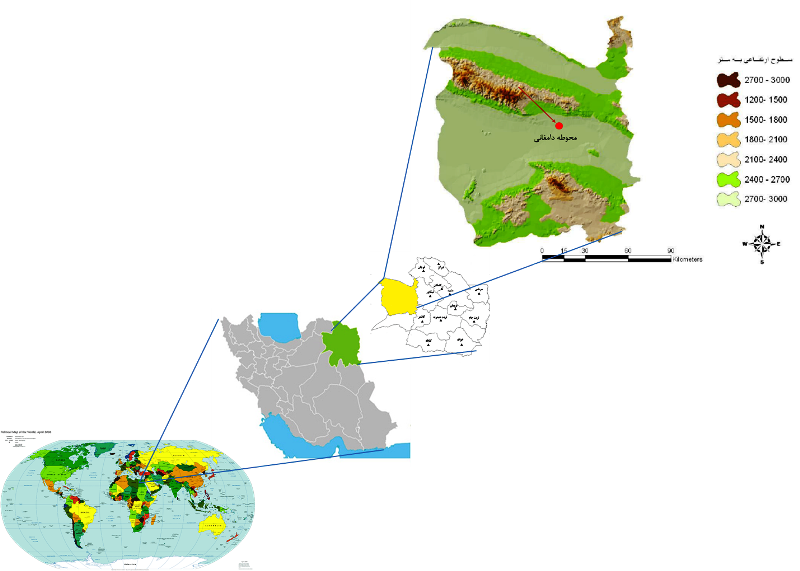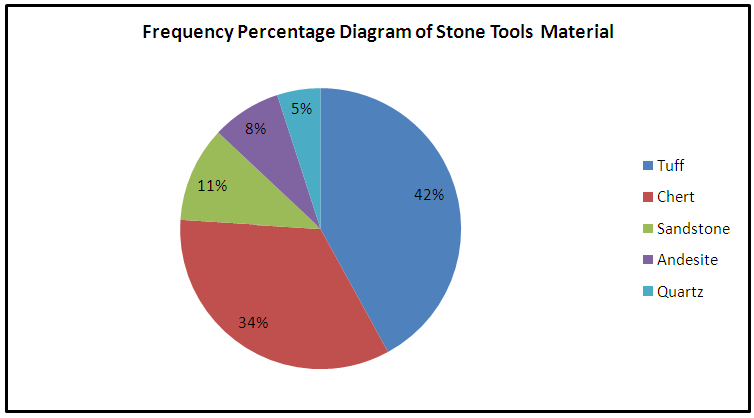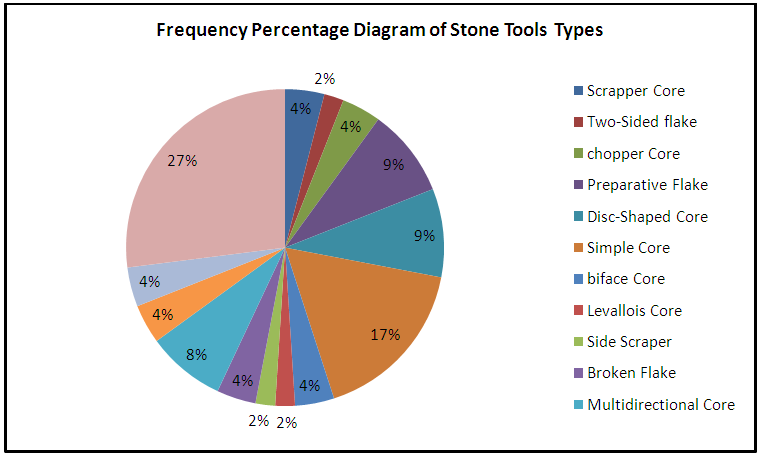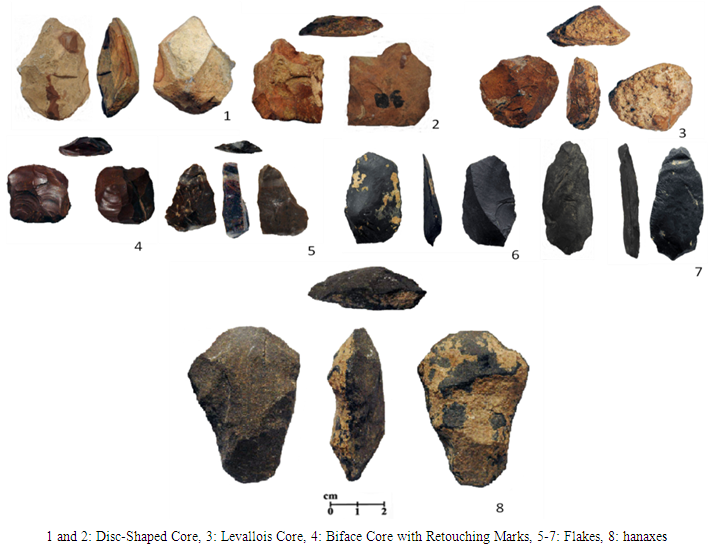-
Paper Information
- Paper Submission
-
Journal Information
- About This Journal
- Editorial Board
- Current Issue
- Archive
- Author Guidelines
- Contact Us
Archaeology
p-ISSN: 2332-838X e-ISSN: 2332-841X
2017; 5(1): 1-6
doi:10.5923/j.archaeology.20170501.01

New Evidence of Middle Paleolithic Period in Sabzevar Plain, Northeast of Iran
Ali Sadraeil1, Mehdi Fallah Mehneh2, Hadi Saburi3, Omran Garazhian4, Mahya Azar5
1M.A. Graduate of Archaeology, Tarbiat Modarres University, Tehran, Iran
2Torbat Heydarieh University, Iran
3Ph.D. Student of Archaeology, Art University, Isfahan, Iran
4Neyshabour University, Iran
5M.A. Student of Archaeology, Neyshabur University, Iran
Correspondence to: Ali Sadraeil, M.A. Graduate of Archaeology, Tarbiat Modarres University, Tehran, Iran.
| Email: |  |
Copyright © 2017 Scientific & Academic Publishing. All Rights Reserved.
This work is licensed under the Creative Commons Attribution International License (CC BY).
http://creativecommons.org/licenses/by/4.0/

Although methodic and extensive studies have been conducted on the Middle Paleolithic Period in western Iran, which provide a relatively clear image of the lifestyle of hunter-gatherer societies and their tool making traditions in these regions, conditions are quite different in eastern Iran, especially in Khorasan, and we have very little information about Paleolithic Period and its tool making traditions. Damghani Ancient Hill of Sabzevar in northeast of Iran, in addition to introducing artifacts of Chalcolithic and Bronze Periods, introduces an open air Site of Middle Paleolithic, based on the tools discovered on surface. The discovered tools include a flake-based industry, where in addition to Levallois and disc-shaped cores, chopper cores, handaxes and multisided core, as well as core scrapper and heavy scraper cores can be identified; which makes it difficult to dateline the collection. By the way, considering the tool making techniques of the Middle Paleolithic Period, we may conservatively relate the tools found in Damghani Ancient Hills to this period.
Keywords: Middle Paleolithic Period
Cite this paper: Ali Sadraeil, Mehdi Fallah Mehneh, Hadi Saburi, Omran Garazhian, Mahya Azar, New Evidence of Middle Paleolithic Period in Sabzevar Plain, Northeast of Iran, Archaeology, Vol. 5 No. 1, 2017, pp. 1-6. doi: 10.5923/j.archaeology.20170501.01.
Article Outline
1. Background Studies
- Paleolithic studies in white archaeological regions of Iran is at the beginning of its way, due to limited archeological activities, lack of attention paid to the prehistoric periods, and the dynamic and active geological conditions of Khorasan. The little information available in this regard is indebted to the short and dispersed archaeological studies and reports. Carleton Stanley Coon was the first researcher who conducted Paleolithic studies in Khorasan. He identified and explored a number of caves in east of Mashhad; but he did not start excavation due to vastness of the area. He also studied and excavated Khunik Rock Shelter (Coon 1951). In 1964, Charles McBurney identified 25 caves in east of Khorasan and Mazandaran, and excavation in some of them; but despite of his studies, he could not find any evidences of the presence of hunter-gatherer societies in these caves (McBurney, 1964). Thibault and Ariai discovered 7 Paleolithic sites in Kashafrud region and related them to Pre-Acheulean Industry (Ariai and Thibault, 1975). Also, in recent years several Paleolithic sites have been indentified and explored in various parts of Khorasan (Jami al-Ahmadi 2008, Jami al-Ahmadi et al 2011, Barfi and Sorush 2014, Barfi et al, 2014).In general, the northeastern of Iran is very obscure during the Paleolithic period, especially during the middle Paleolithic period; As a result of this era, no significant area has been identified between the Kashafrud sites in Mashhad Plain and the Kayaram Cave in Gorgan Plain (500 km distance). However, due to the small amount of data obtained from these sites and other single findings, the chip industry in the northeast of Iran can be considered to be chip-based industrial, which in terms of access to raw material, often has a native rock source and technically the use of Lavalau's technique is common. Damghani sites in the Paleolithic period depends on the Sabzevar ophiolite belt with stone resources have been varied.
2. Natural-Cultural Landscapes and Geological Conditions of the Region
- Geologically speaking, the subject region is a part of Central Iran, which is covered by young alluvial deposits of Quaternary period. This region consists of various geological landscapes varying from clastic and alluvial sediments on surface of the planes to colorful mixtures and volcanic stones (Fouache et al, 2010: 288). Such a geological setting made various raw materials, stones, aggregates, and colorful masses available to the prehistoric settlements (Garazhian and Saburi, 2012). On the other hand the ophiolite suite of Sabzevar, which is one of the major ophiolite suites of Iran with various sources of stones, has been a local source of stones available to and considered by the human societies in Paleolithic Period (Saburi et al, 2014:99). Damghani Ancient Hill is located in northeast of Iran, at the southwestern margins of the City of Sabzevar, the geographical coordinates of 36° 11’ 54” N and 57° 42’ 23” E, and altitude of 950 meters above the seas level (Figure 1). This site has been explored and excavated in several seasons, and artifacts of Chalcolithic and Bronze Periods have been discovered in the site (Vahdati and Frankfurt, 2010; Garazhian et al, 2012; Garazhian, 2015). During the 2015 excavations in southern wing of Damghani Ancient Hill, a number of tools were discovered which carried dens stone patina effecta and were of different flaking techniques, unlike the other artifacts discovered in the site. Accordingly, a number of tools were sampled randomly, to study their morphology and tool making techniques (Figure 2).
 | Figure 1. Location and Topography of Sabzevar Plane (Picture Made by Authors) |
 | Figure 2. Landscape of Southern Wing of Damghani Ancient Hill (Picture Made by Authors) |
3. Stone Artifacts of Damghani Hill
- Totally 38 stone artifacts were sampled during Damghani Hill explorations. These artifacts are flaked from medium and high quality brown, cornelian, and matt white chert stones (34%), medium and high quality light green and dark green vitric and lithic tuff (42%), medium quality brown sandstone (11%), dark brown to light brown andesite (8%), and medium quality quartz (5%) (Figure 3). The discovered tools include simple core (2 pieces), multisided core (4 pieces), Levallois core (1 piece), disc-shaped core (4 pieces), biface core (2 pieces), core scraper (2 pieces), cleaver core (2 pieces), simple flake (8 pieces), broken flake (2 pieces), preparative flake (4 pieces), two-sided flake (1 piece), flake retouched on sides (2 pieces), heavy side scraper flake (2 pieces), side scraper (1 piece), and a highly weathered 8 5 cm handaxes artifact, whose width reduces gradually from bottom to the top, and ends by 2.5 cm (Figure 4). Considering the dense patina effects, the used material, and the applied flaking technique, it can be considered one of the bifaces tools used in the early Middle Paleolithic Period. Also, there are two chopper tools amongst these artifacts. One of the samples, which is made of andesite and carries patina effects in some parts, is partially eroded and corroded. The other sample, which is made of quartz raw material, can be compared to the samples discovered in Kashafrud (Biglari, 2015).
 | Figure 3. Frequency Percentage Diagram of Stone Tools Material (Picture Made by Authors) |
 | Figure 4. Frequency Percentage Diagram of Stone Tools Types (Picture Made by Authors) |
 | Figure 5. A Selection of Artifacts Discovered in Southern Wing of Damghani Hil |
 | Figure 6. A Selection of Artifacts Discovered in Southern Wing of Damghani Hil |
4. Discussion and Conclusions
- Damghani is one of the few sites which have been used after Paleolithic Period in more recent sedentary periods. The artifacts discovered in this site can be generally compared to the contemporary open air sites of Iran. Thus, the subject collection can be conservatively related to a flake-based tool making traditional using Levallois techniques in the early Middle Paleolithic Period. Considering the fact that majority of the discovered artifacts consist of initial phases of peeling and flaking processes, and that the number of final tools and artifacts are much smaller that the number of other artifacts (cores, simple flakes) we can say that the southern wing of Damghani Hill had been a workshop where the initial phases of flaking were done, and final products were taken to another place. The said activities were outcomes of the difference between open air sites and rock shelters and caves, which are mostly accompanied by slaughtering the hunted animals, and initial tool making processes.
ACKNOWLEDGMENTS
- We hereby thank Dr. Feredun Biglari for his morphological study of the samples and his guidelines, Mr. Rahmat Naderi for reviewing the article and providing us with his valuable and useful viewpoints and suggestions, and Mr. Milad Hashemi for drawing the artifacts.
 Abstract
Abstract Reference
Reference Full-Text PDF
Full-Text PDF Full-text HTML
Full-text HTML